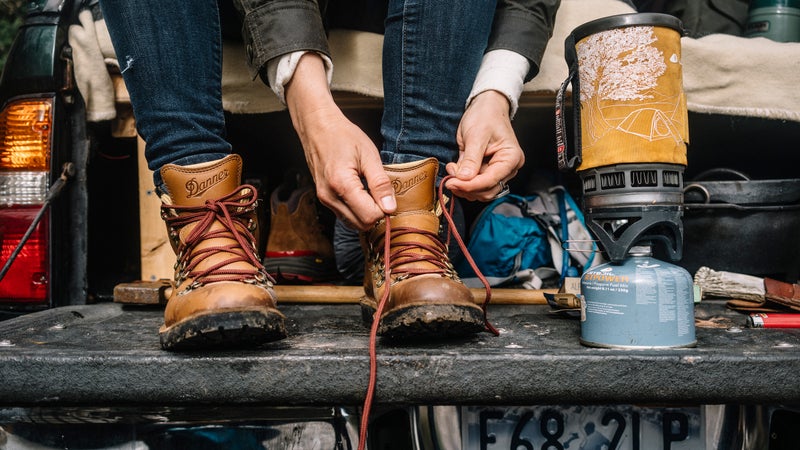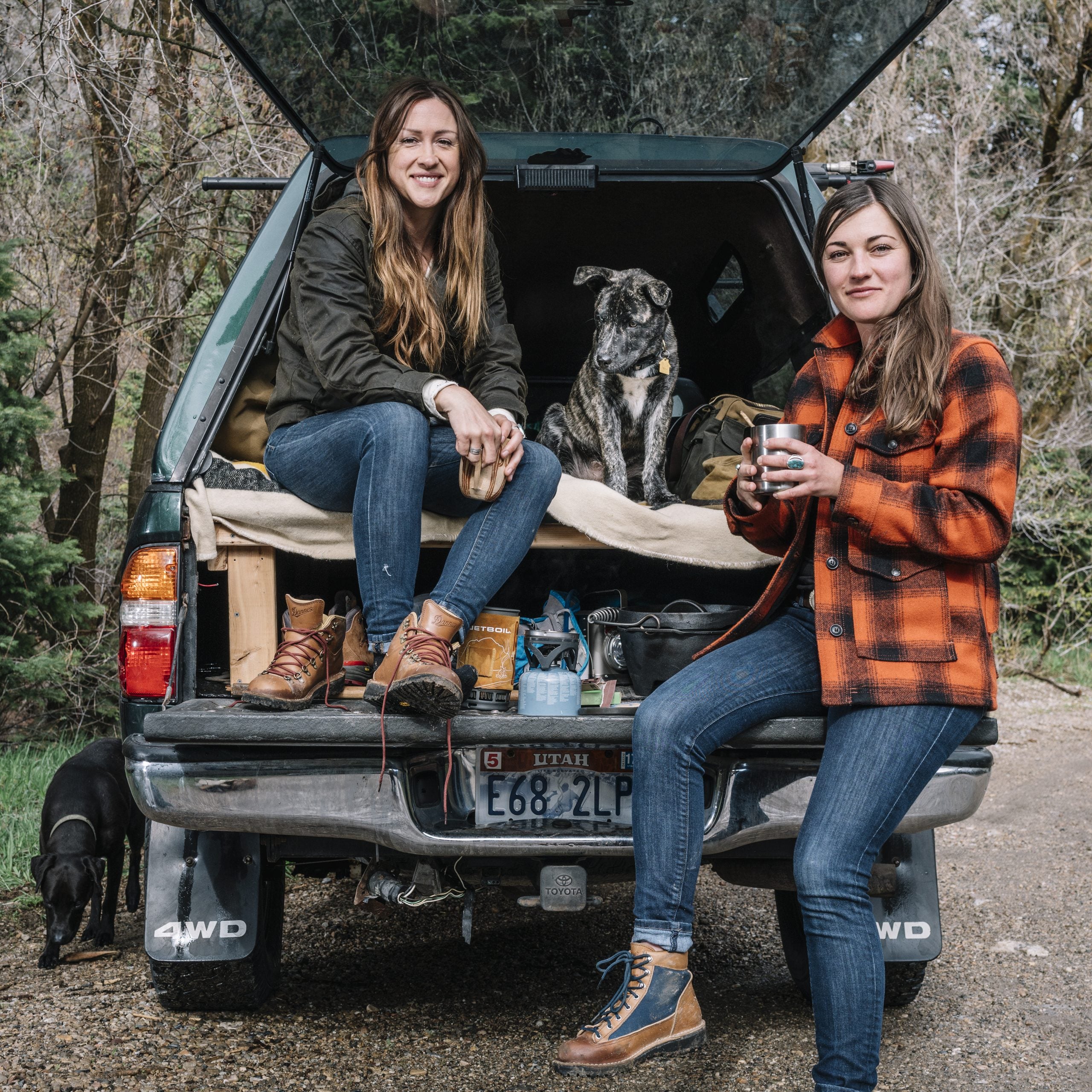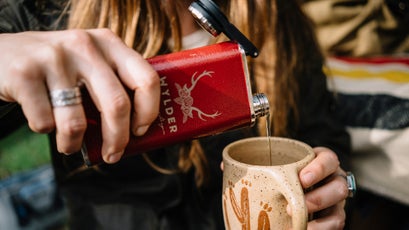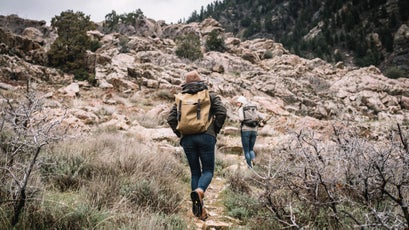The women at Wylder Goods had a big dream: to create the world's first online outdoor-gear retailer for women, bust into an industry overrun by bros, and save the planet. All in four not-so-easy steps.
Step One: Embrace Your Ambition
One night in March 2015, housemates Jainee Dial and Lindsey Elliott were sitting on a leather couch in front of a woodstove in their Northern California home, sipping Bulleit bourbon, eating Mexican food, and hashing out the details of their plan to infiltrate the outdoor industry.
“We need to work with companies striving for social and environmental impact,” Elliott said.
“And we want them to be disruptive,” Dial added. She took a sip of bourbon and rested her glass on the coffee table. Then reality began to sink in.
“Holy shit,” said Dial. “We’re up against giants.”
There was good reason for trepidation. The duo were hatching the business they’d ultimately call Wylder Goods, the world’s first online outdoor-gear retailer for women. Over the past decade, dozens of e-commerce sites have launched to sell gear from a broad range of brands. The biggest players, like Backcountry.com and Evo, generate tens of millions in revenue by offering massive selection and, frequently, big discounts. More recently, boutique outfits like Huckberry have made their mark by presenting highly curated inventories that attract loyal, discerning buyers. But while some sites have sections for women’s products, nobody had tried to build a business catering primarily to female consumers—especially not core adventure athletes.

Dial and Elliott envisioned a company that did exactly that. The gear would be selected by Wylder ambassadors—professional athletes, photographers, activists—who’d test each product for durability, fit, and function. Product descriptions would occasionally be raw. “Things like ‘This shirt contours your muffin top,’ ” Dial told me later. Wylder would also be one of the outdoor industry’s few benefit corporations, or B Corps, meaning that it would be obligated to donate, in its case, 2 percent of its proceeds to outdoor nonprofits.
Dial, 36, had been nurturing the Wylder idea since July 2013. At that time, she owned an adventure-travel company in Portland, Oregon, called Nomad, which ran small yoga, surfing, and rock-climbing trips along the Pacific Northwest coast. The job frequently reminded her about the dearth of solid, high-performing women’s gear. “The stuff wasn’t cool,” she says. “It was ugly. For women the options were khaki or paisley that none of us really wanted.” After a year running it, Dial sold Nomad. “It was a crash course in business,” she says. “At that point, I wasn’t willing to make the sacrifices necessary for it to be successful.”
While some sites have sections for women’s products, nobody had tried to build a business catering primarily to female consumers—especially not core adventure athletes.
Around then, Dial met Brad Parker, an accomplished rock climber and massage therapist, at a yoga festival in Squaw Valley, California. “We started talking and didn’t stop,” says Dial. “After three days, he told me he loved me.” With nothing tying her to Oregon, Dial moved to Sebastopol, an artists’ hamlet an hour north of San Francisco, to live with Parker and work as a freelance web developer. A year later, he took her on her first climbing trip in Yosemite, where the two summited Cathedral Peak. After they descended, Dial remained at camp while Parker climbed one more pitch before dinner. That was the last time the couple would see each other: a few hours later, Parker fell 300 feet to his death.
Whenever Dial tells this story, tears stream down her face, and she’ll often look to Elliott for support. Dial spent five months barely able to get out of bed. “The anguish and despair and mistrust—that all your dreams could evaporate,” she says. Then Elliott moved in. A development associate for the Occidental Arts and Ecology Center, Elliot, then 27, had befriended Dial about a year before Parker’s death. She’d recently broken up with her boyfriend and needed a place to live. “She created a whole new space,” Dial says. “Hope.” The two would stay up late crying, drinking whiskey, and, later on, talking about Dial’s vision for Wylder. “Grief has the ability to recalibrate everything,” Dial says. “I had an idea of what my life would look like, but grief comes and takes that away and leaves this vacuum. When you have nothing to lose, it makes it feel less crazy to take a big chance.”
In January 2015, Dial and Elliott attended Outdoor Retailer, a biannual trade show in Salt Lake City that offers gear sellers a first look at the season’s new products. They’d come packing their concept for Wylder at an opportune moment. Industry brands had long treated the women’s market as an afterthought. Even the relatively small percentage of female-specific products created over the years were derivatives of stuff designed primarily for men, results of the maligned “shrink it and pink it” approach. But outdoor companies were increasingly seeing women consumers as a massive growth opportunity—if only they could reach them before the competition.
Dial and Elliott came away from the OR show convinced of two things: nobody was attempting anything like what they had in mind, and several brands, including Patagonia and Zeal Optics, were struggling to get their women’s lines to consumers. “It’s happening,” Elliott confided to one of her friends when she returned to California. “I’m not sure when, but it’s happening.”
Step Two: Network Like Crazy
By April 2016, it was, in fact, happening. The company finally had a name, which Dial had thought up one day in the shower. “I took it from wilderness,” she says. “And I liked the way the y looked.” It also had a base: Salt Lake City, Dial’s hometown. Over the previous year, the women had developed key parts of the company—relationships with women’s outdoor groups, narratives for the website, and logos—and consulted with e-commerce pros on everything from logistics management to back-end web design.

They also created a Kickstarter campaign. “Neither of us came from money, so we had to do something else,” says Elliott. Crowdfunding has become a highly successful business strategy for outdoor companies. Kickstarter’s top three most-funded projects (two Pebble smartwatches and a cooler with a built-in blender and speaker) are active-gear oriented. The platform’s ninth-biggest campaign—with 26,359 backers fronting almost $6.5 million—was built around a messenger bag from a San Francisco–based company called Peak Designs, a regular on the Outdoor Retailer floor.
The Wylder Kickstarter campaign had two goals: generate enough money to get the company off the ground, and prove to outdoor brands that there’s strong demand for an online women’s-gear retailer. It went live April 19, 2016, with a goal of raising $45,000—enough to build out the website, buy initial inventory, cover basic legal work, and, with whatever was left over, pay themselves—an amount they figured would come to only a couple of thousand dollars. They’d produced a four-minute video for the campaign, which, through trades and favors, had cost them less than $500. In the clip, you watch as women surf, run, and backpack. “What inspires me about Wylder is a chance to build a better business,” Elliott narrates. “The chance to take all the best things that are built to last, that are built with social and environmental good in mind, and celebrate them.” For prizes, Dial and Elliott offered donors everything from trucker caps to a weekend bouldering in Moab led by the women and professional climber Kevin Jorgeson, a close friend. They mobilized a grassroots campaign, recruiting a network of brand reps, industry influencers, active women, and friends to spread the word.
I had an idea of what my life would look like, but grief comes and takes that away and leaves this vacuum. When you have nothing to lose, it makes it feel less crazy to take a big chance.
At 1:30 that afternoon, Elliot and Dial were holed up at Dial’s parents’ house in Draper, Utah, drinking LaCroix, eating dark chocolate, and staring at a computer screen. For four minutes nothing happened. “It was the longest four minutes of my life,” says Elliot. “Then—ding! Backer alert!” One of her high school friends had just donated $1, enough to encourage others to follow suit. Within an hour and a half, the women were scrambling to find more donor gifts. By the time the fundraising drive had ended, in May 2016, they’d received more than $54,000 from 606 backers. That, plus a low-interest loan from a friend, allowed the women to move forward with Wylder.
“The Kickstarter campaign proved that we had buying power with vendors,” says Elliott. Indeed, while 600 backers doesn’t sound like much, the sudden emergence of a passionate group of women willing to put money into the idea caught the industry’s attention. As Tyler Nelson, Patagonia’s sales representative in Utah, put it, “They have a following that established retailers would kill for.”
Step Three: Hustle
A few days into August 2016, I met Dial and Elliott at the Salt Palace Convention Center, at Outdoor Retailer’s summer show, where the two ruddy-cheeked brunettes—so similar in appearance that they could pass for sisters—greeted me with smiles and an abundance of self-esteem. “See my key chain?” Dial asked. Engraved in it were the initials JMFD. “Jainee Motherfucking Dial,” she chuckled.
Their website, WylderGoods.com, was about half complete, and the two were at OR to curate the products they’d sell through it. To control their branding, outdoor-gear manufacturers—particularly big dogs like the North Face and Patagonia—can be picky about who they let sell their products. I expected the Wylder women to have to plead with companies to hear out their strategy. So I was surprised when, during a meeting with Salomon, Dial and Elliott dressed down a marketing executive for what they deemed were products with a less-than-satisfactory environmental impact.
“Is Salomon talking about using the Higg Index?” Elliott asked.
“I’m not sure what that is,” the executive responded.
“It measures the impact of products on the environment,” said Elliott.
“I’d give Salomon a four out of ten on sustainability,” Dial interjected.
“Your competitors are using the Higg Index, so you should at least look it up,” said Elliott.
Nonetheless, the Salomon exec was soon fawning over the women. “We’re not taking on more online retailers,” she said. “But we’re gonna push for you guys.” Walking to the next meeting, Dial explained that they’d become used to such receptiveness. “Patagonia wasn’t taking on more e-commerce sites, either,” she said. “But they made an exception for us. They even waived their minimum order requirement.”
The fact that outdoor brands are so eager to reach women gives Wylder an advantage over other gear-curation sites. Nike reported a 20 percent jump in sales of women’s products in 2015, while men’s products grew just 9 percent; it’s projecting $11 billion in sales of women’s products by 2020. This spring, REI launched a massive women’s initiative, Force of Nature, that included millions of dollars in ad spending and more than 1,000 events. Across the industry, while many segments stagnate, women’s-gear sales are growing (by nearly 10 percent year over year in 2013, the most recent data available). The first online storefront to successfully tap this awakening giant is going to clean up. Of course, that requires building a functioning business. And fast.
Step Four: Buckle Up
In February, three months after the launch of the website, I meet with Dial, Elliott, and Gina Peters—a recent full-time hire who handles contracts and logistics with vendors—at their new office inside an old chocolate factory in Salt Lake City. They moved in last November, after working from Elliott’s living room for seven months.
The office is cozy, just big enough for three desks, a couch, Elliott’s Lab-Doberman rescue, Moka, and a rug that doubles as Dial’s yoga mat. One wall is plastered with catalog clippings from various companies, products that will make it onto the website. A whiteboard, scribbled with sales goals, takes up another wall. Dial shoots all the product images for the site on a piece of white butcher paper in a corner of the room, and the women store inventory in a basement unit they share with Gold Coast Skateboards. Five brands have agreed to ship directly from their warehouses to consumers, allowing Wylder to carry more products, and the women have started experimenting with presales as well, to better gauge demand.
“There are 2,000 reasons the world doesn’t want your business to succeed. I’ve questioned my self-worth, cried myself to sleep, and asked myself more times than I can count, ‘What the hell was I thinking?’”
WylderGoods.com went live on November 23. To build its guts, the women hired a coder, but the style and design of the pages is all theirs. It’s attractive and easy to navigate, and will sell products from about 70 companies, including Carve Designs, Patagonia, and United by Blue.
To date they have yet to make full use of their ambassadors—women like Krystle Wright, an Australian adventure photographer, and the Salmon Sisters, a pair of Alaskan anglers. The plan is to eventually pay them to help lead events, like a photography workshop or a fishing trip, as well as to write blog posts and promote Wylder to their followers on social media. More concerning is that sales have been slow. The company’s biggest day was in December 2016, when it sold 16 products and made around $2,000. “We’re able to pay bills,” says Dial. “But we’re barely paying ourselves.”
There’s also an encroaching feeling of burnout. The women are constantly working to pack inventory and fill orders, market the company, and do the accounting. “I’m a basket case a lot of the time,” says Dial. “There are 2,000 reasons the world doesn’t want your business to succeed. I’ve questioned my self-worth, cried myself to sleep, and asked myself more times than I can count, ‘What the hell was I thinking?’” she says. “I’m not very good at faith, so often I just try to remind myself that on the other side of this sacrifice is a landscape that looks entirely different.”
Loss of momentum isn’t unusual for crowdfunded projects. In 2012, Daniel Freschl raised more than $49,000 through Kickstarter for one of the first rechargeable headlamps. He quickly sold 1,000 units, mostly to people who’d supported his campaign, and built another 2,000. Those sold, too, many to customers who’d received coupon codes from early Kickstarter backers. But scaling up proved difficult. In three years, Freschl was out of business. “To a certain extent, I think Kickstarter made it harder for me to be profitable,” says Freschl, who now works as a mechanical engineer for Fitbit. “It gave me the opportunity to launch a project without proper funding. I got in over my head without somebody with deep pockets behind me.”
But Dial and Elliott remain optimistic. To increase their reach, they’re partnering with women’s outdoor groups on the East Coast. They’re experimenting with Facebook ads. There’s talk of converting Sprinter vans into mobile stores. And in January, they began seeking out investors and talking with people from B Lab, a nonprofit that helps benefit corporations find funding. “We only want to be working with people keen on social-impact investing,” says Elliott. “In retail that’s a very tiny pool.”
On the day of my visit, the women have a conference call with David Stover, cofounder of Bureo, a company that builds skateboards from old nylon fishing nets and also launched on Kickstarter. Three years ago, Bureo received a crucial second round of investment, from Patagonia’s capital fund, Tin Shed Ventures. “It’s been an unreal experience,” Stover says. “We went from not knowing what that partnership would look like to—fast-forward three years—working on the R&D of fabrics for a Patagonia line. We’re looking at sourcing our nylon to be used in jackets and other products. The benefits of the relationship have gone far beyond any financial support they provided.”
“That’s a beautiful story,” says Elliott.
The call ends, and the two women look at each other and smile. Then they get back to work.
Correspondent Gordy Megroz (@gordymegroz) wrote about Kikkan Randall in March.





